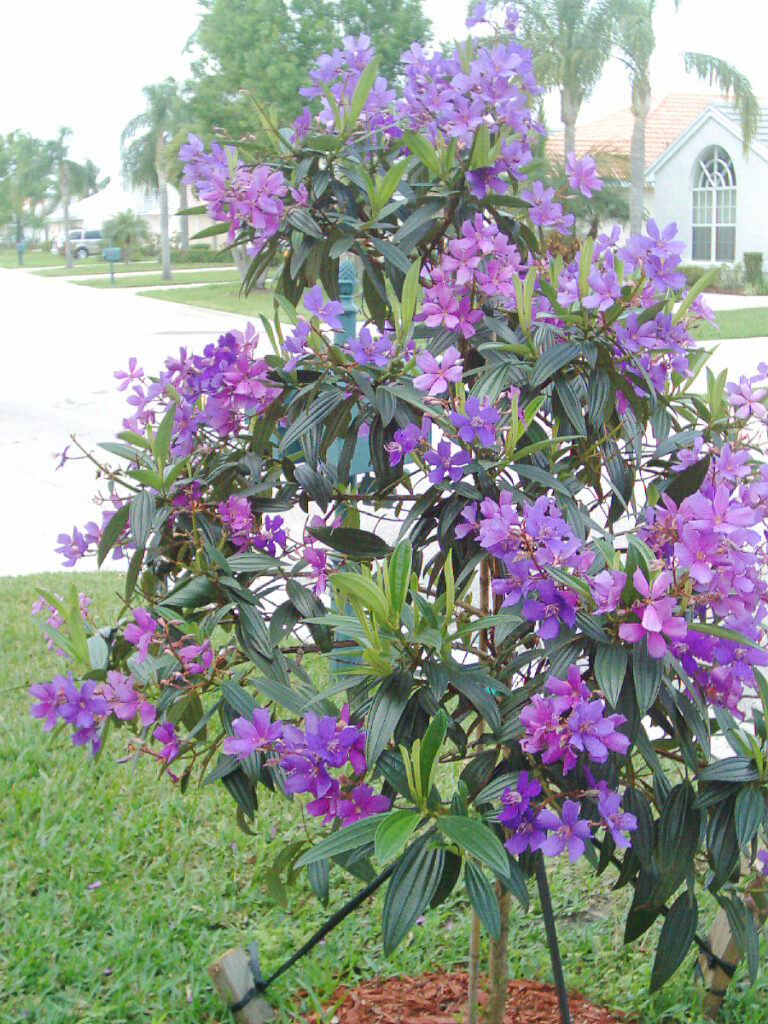Q: My neighbor has this tree near his front door. It has magnificent intensely purple flowers and fuzzy leaves with veins running longways in them. I say it is a tree, but my neighbor is constantly fiddling with the support straps to ensure it stands up. What is this plant? Is it a tree? Where is the best place to grow it to support itself? I’m not too fond of the ugly black straps most folks use to hold the plant vertical.
Julie,
Port Salerno, FL

A: Tibouchina urvilleana, also known as Princess Flower, Glorybush, or Glory Bower, makes electric royal purple flowers and pubescent or fuzzy leaves. Flowers are the main attraction of these tender tropical beauties. Here’s how to grow Tibouchina in the landscape.
Tibouchina is an evergreen shrub or small tree though frosty or dry weather can knock the leaves off. The oval-shaped velvety leaves are large with a pointed tip, a finely toothed margin, and 3 to 5 deeply impressed parallel midveins; they look like a downy quilt. The branches are square, winged, and somewhat brittle. Stunning flowers are borne in groups at the end of the branches and are 2 inches across with 5 petals. Beautiful blooms are most abundant from May – January, though some appear throughout the year in central and south Florida. The fruit that follows the flowers is inconspicuous, a ½-inch capsule with tiny but interesting seeds shaped like spiral shells.
Native to the rainforest of South America, the hot afternoon sun and dry season can be rough on Tibouchina. Choose planting locations with sun in the morning and shade in the afternoon or high shifting shade. The soil should be well-draining and supplemental irrigation available. Protect the plants during cold weather in areas prone to hard frost and freezes. Severe damage or death can occur.
However, Princess flower does not like wet feet. Regular watering when rain is lacking is required for good growth and flowering. Micro or drip irrigation would be an excellent choice to keep the plant moist without overwatering the rest of the landscape. Mulch to conserve moisture, cool the roots, and suppress weeds.
Tibouchina is susceptible to several pests. Inspect regularly for scale, mealybugs, and aphids. If control is necessary, check out insecticidal soap and/or horticultural oil. Nematodes, microscopic roundworms that feed on the roots of plants, can cause an overall decline, leaf drop, and lack of vigor. However, the damage is indistinct and easily confused with the damage caused by hot, dry locations and weather. Mushroom root rot is also a problem in wet or over-irrigated areas.
Tibouchina is a large sprawling plant. It can be pruned to look like a tree but may need support until the trunk attains enough girth to support the plant. It can be trained on a trellis or archway, but support may be necessary for most of the plant’s lifespan. Tibouchina is beautiful as a container specimen and may be the best place for planting. Glory Bowers has escaped cultivation in Hawaii and may do so in Florida, so keeping the plant contained is a good idea.
This column first appeared in the Treasure Coast Newspapers.
Leave a Reply